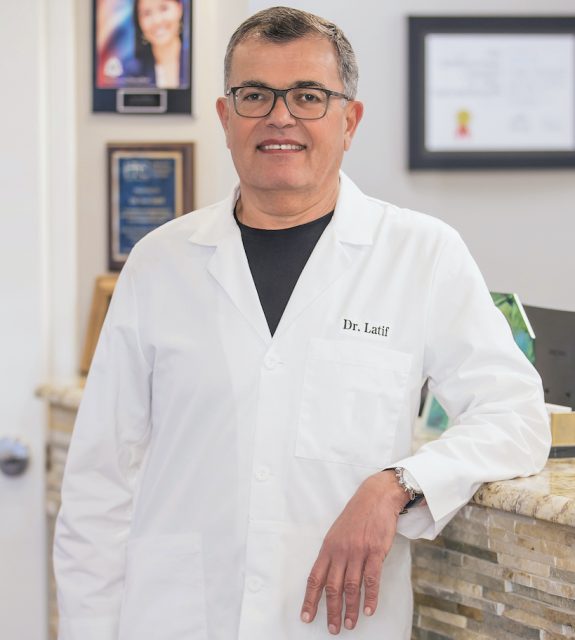 Photo Credit: Photo courtesy of Cantor Spine
Photo Credit: Photo courtesy of Cantor Spine
Spine and joint expert Dr. Anthony Giuffrida of Cantor Spine Center at The Paley Orthopedic & Spine Institute, located in Fort Lauderdale, Fla., is a board-certified physiatrist and is fellowship-trained in interventional spine and sports medicine. Dr. Giuffrida is at the forefront of significant advancements in the management of pain.
According to Dr. Giuffrida, spinal cord stimulator (SCS) systems have been around for some time now, but with the evolution of medical technology, each SCS is now smaller with many more capabilities.
Medtronic, the specific brand that Dr. Giuffrida uses for spinal cord stimulation, is the only brand that allows patients with the implanted device to continue to get MRIs. Additional benefits to the new technology is the interface system, which has Bluetooth capabilities that allow Dr. Giuffrida to observe from a tablet to see how a patient is using the SCS, and then he can adjust programs accordingly to provide better relief.
Dr. Giuffrida sat down with Haute MD to answer some of the most common questions he’s asked regarding spinal cord stimulation therapy.
Who is someone that can benefit from SCS?
Most patients that have a SCS have already had lumbar back surgery, but are still experiencing significant pain. Instead of going back to the operating room for a new surgery or fixing the previous surgery, we use a spinal cord stimulator above the level where the surgery was performed, and it shuts off pain from the surgery and pain going down the legs. When back surgery fails to properly treat pain, we call this post-laminectomy syndrome. SCS helps treat this condition.
The other group of patients that benefit from SCS are patients that have CRPS, which is complex regional pain syndrome. This is when patients experience fire-like pain in their arms, hands, legs or feet. CRPS is generally from a previous nerve injury. For example, if someone broke their ankle and still experiences pain after the ankle heals, the patient is believed to have nerve pain. To treat the pain, we will use a SCS to help shut off the hyperactivity from the nerve.
SCS can also help patients that aren’t able to undergo a full-fledged major back surgery. If there is a spinal deformity, such as scoliosis or a slipped disc, the deformity generally needs to be fixed first for the stimulator to provide the best outcome.

What is the procedure like?
We perform the SCS in an outpatient procedure in the office where we implant the leads [wires] of the stimulator. The battery actually sits outside the patient’s body under tape and sterile dressing for about a week. The nice thing about this is the patient can tell me how they [are doing] before we totally implant the SCS. The patient keeps a diary for about five to seven days documenting what’s better and what isn’t better with their pain. Then, if the patient does well, we go back, take those leads out and we implant the new leads, and we implant a battery under the skin. One of the things I say about the simulators is that it’s the only procedure that you can [do a] trial first before you end up getting the permanent device.
The battery is about the size of a large watch head. It goes underneath your skin, in your right or left flank, in between your hip bone in your ribs, and the leads themselves are very thin, tiny wires. Patients say the new batteries are not too intrusive.
We put it into the epidural space, which is just posterior to the spinal cord, and the stimulation penetrates into the spinal cord on what’s called the dorsal column or the posterior aspect of the spinal cord, which is where a lot of our pain signals originate. The SCS blocks pain signals from below wherever we place the lead.
Is this new technology?
Spinal cord stimulation therapy has been used for many years. With new advancements, we are finally really honing it and figuring out the technology and are now able provide the best outcomes and relief for our patients. What’s changed is the computer system that programs the code to run the type of stimulation. All the research now is looking at the type of simulation.
The other advancement is the size of the battery. The battery used to be massive—and intrusive. If you think about cell phone batteries 20 years ago and how big they were, that’s what would have been implanted in your back. Now, the battery is much smaller, the stimulation works better and the charges last longer. That’s why we’re seeing an uptick in the number of patients that are benefiting from SCS.
The nice thing now [is]the new SCS batteries are also computers. I’ve been calling them batteries, but it’s also basically a computer inside which we can update through Bluetooth technology. We are able to monitor when a patient’s using the SCS, when they’re not using it, plus what kind of frequencies they‘re using. The new technology allows us to see which program they really need.
Is this a long-term solution to chronic nerve pain?
Yes, the batteries last nine years. Some of the batteries last even longer, and if it’s still working and the battery just dies, all we do is another procedure where we take the battery out, replace it with a new one in and hook it up to the leads that are already there.
For more information, visit Dr. Brian A. Levine's social media:

























